On the right track at Drax
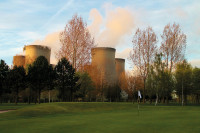
The winter of 2015-16 was one of the wettest on record, which has forced us to use temporary greens more frequently, and close the course in some instances, just to protect the main greens. So, this coming season, we aim to rectify this by carrying out a combined treatment of aeration and topdressing to improve winter playability. We also plan to encourage Fescue grasses (Festuca) into the sward through topdressing and species management.
Nine of the twelve greens at Drax were constructed using native clay soil push-up method. The profile beneath the greens is:
- Sandy root-zone profile (80-120mm
- Native clay soil pushup (100-150mm
- Ash drainage pan (Varying depths)
When we change pin positions, we regularly look at the plug to analyse the soil profile and discuss ways we could make any improvements.
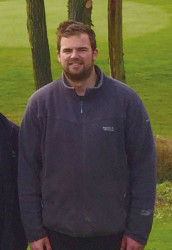
The push-up method has been used traditionally in the past, but unfortunately it has the following disadvantages:
- The soil swells up due to absorption of water, creating a spongy surface in winter
- The soil freezes deeper during heavy frosts due to increased moisture. This can supress beneficial microbial activity
- The soil becomes incredibly hard during summer and stops water being absorbed into the profile
- The dense clay has less pore spacing and has poor infiltration rates
- Grass roots find it difficult to penetrate the hard clay profile. This reduces root depth and causes root breakage
- The waterlogged profile forces microbes to work anaerobically (without air), this encourages black layer
It is important to accept the type of soil you have because it's very difficult to completely change the texture without totally reconstructing the greens. However, it is possible to subtly modify the soil texture using sand amelioration to improve the drainage of the rootzone. By doing this, you can broaden the particle size distribution in the soil, increase the pore spacing and speed up the rate of water infiltration.
One of the good points about clay soil is that it has a higher cation exchange capacity than most other soils. This means that it retains more nutrients and also provides us with better value for money when using fertilisers or other chemical treatments.
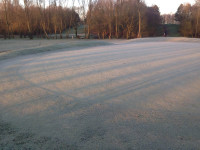
We wanted to follow best greenkeeping practices, so we conducted research into how other golf courses have improved their push-up greens.
After discussions and careful consideration, we decided that the best course of action would be to carry out a two-phase strategy of aeration and topdressing over the course of a year. The programme will be as follows:
Firstly, as soon as any chance of frost has gone, we will hollow core to a depth of 70mm. This will be followed by a topdressing of three tonnes per green using round shaped sand.
Secondly, during our autumn renovations, we will verti-drain the greens using 18mm diameter tines, to a depth of 8-9 inches. This will be followed by another heavy topdressing of round shaped sand.

When the pore spacing between particles fills up with water, the soil is known as saturated. At this point, the speed that water travels in the spacing between the particles is known as the hydraulic conductivity. Water is only pulled down through the rootzone when gravitational force becomes too great. This happens when the height of water through the profile reaches a critical depth. This depth of water required for a soil to drain is affected by its texture. On sandy soils, the depth of water only needs to be shallow, but on clay soils it has to be much deeper. This is because the particles in clay are tiny with less pore spacing, a larger surface area and greater surface tension. The surface tension creates cohesive forces, which holds water in the profile and doesn't allow it to drain.
Encouraging the finer grasses
This season we want to encourage finer grasses into the sward by overseeding with 80% Eurocrown Chewings fescue (Festuca Rubra) and 20% Jorvik Bentgrass (Agrostis Tenuis). This will be part of our long term overseeding programme in conjunction with changing the way we maintain our greens.
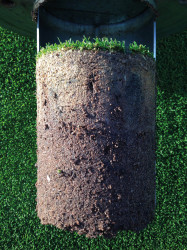
Grass seed is expensive and we don't want to waste any. We plan to do everything possible to ensure the best germination rates. To have a successful overseeding programme, we plan to follow these steps:
1. Choose the best cultivar for the conditions of the green
2. Carry out overseeding when conditions are favourable and enough water is available
3. Create a suitable seedbed prior to overseeding
4. Insert the seed properly into the green so it makes direct contact with soil
5. Nurture the seed during establishment and keep any practices that cause seed disturbance to a minimum
6. Manage the greens to encourage the right environment for the cultivar we are trying to establish
We are going to use a star-seeder, after hollow coring, to integrate seeds into the sward. This will ensure that there is seed-soil contact. The best thing about having a regular overseeding programme is that we can keep our sward up-to-date with the latest seed technology. This can provide benefits such as:
- Improved drought resistance
- Disease resistance
- Improved green speed
- Shade tolerance
- Better recovery
- Less thatch production
- Increased competition against weed grasses
Species management

Fescue is a delicate species but, if provided with the right conditions, it can thrive. Unfortunately, it does not like low cutting heights, excessive nitrogen application, excessive water application or an environment that is constantly disturbed. If we want to encourage this grass, we need to change the management strategy on our greens. This year, in conjunction with the improvements to the drainage of the green, we also plan to:
- Keep the cutting heights no lower than 4mm in the summer and 6mm through the winter on the greens - to allow the Fescue to thrive
- Only apply the minimum amount of nitrogen required to sustain healthy grass on the greens
- Carry out disturbing cultural practices aggressively but less frequently. The Fescue is only capable of sustaining disturbance for a short period of time
- Try to miss out 2-3 perimeter cuts on the greens through the week and replace with light rolling if we feel the putting surface will still have good playability
- Carefully manage the amount of water applied to the greens through summer to avoid giving the grass too much, which will discourage annual meadow-grass
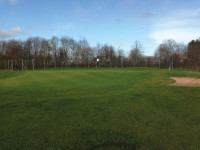
Improvements we have made so far
This winter, as an experiment, we decided to trial a treatment on the 1st green, as it is one of the wettest on the course. We wanted to create channels leading from the surface right down to the drainage bed so water could be removed from the rootzone.
We marked out areas over the green at 2 metre spacing and removed hole plugs with the holes cutter at these points. We then drilled 100mm diameter soak holes through the profile to a depth of 600mm, using a petrol-powered auger. These holes were then backfilled with pea gravel 200mm short of the surface. The hole plugs were then replaced to leave no sign of damage to the green.
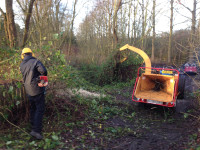
As part of our ongoing woodland management programme, we have cleared out large areas of scrub and self-seeding trees from around the course. This has opened the course up and has improved air movement around some greens. This has also helped to prevent disease and given golfers a chance to play shots out of these areas, thereby improving playability.
We still have a long way to go and there are still other areas we have plans for improvement in the future. However, now that we are following a carefully thought out plan, we feel we are on the right track at Drax.
Ben Morgan, First Assistant, Drax Golf Club
BSc (HONs) Sustainable Land Management
Foundation Degree (Fd) Sports Turf Management
